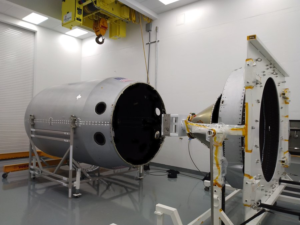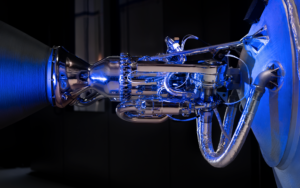
Has Rocket Lab Made Progress On Neutron?
Rocket Lab is still targeting the end of this year for the first launch of Neutron, a partially reusable medium-lift launch vehicle. With such an aggressive timeline, it begs the question of what progress have they made and is that date realistic. Based on the project’s timeline and recent updates, it seems that while maybe not likely, it’s definitely possible.
Just days ago, Rocket Lab completed some large concrete pours for Neutron’s launch pad, future tank farm, and launch mount. This comes in addition to continued work on the vehicle’s Archimedes engines among other aspects. Here I will go more in-depth into the company’s progress, launch site development, upcoming milestones, and more.
Launch Site Progress

Almost two years ago in early 2022, Rocket Lab selected Wallops Island, Virginia, as the location for its first launch site and extensive manufacturing and operations facilities, for Neutron. Since then, a large portion of work has been focused on the vehicle itself and the manufacturing facilities, while the launch site was somewhat left on the back burner. However, a few days ago the company tweeted saying, “A big week of concrete pouring and civil works at Launch Complex 3. Foundations for the water tower, LOx tank, and launch mount are taking shape in Virginia ahead of Neutron’s first flight.” This included a few images of the site’s foundation, general footprint, and progress. While still in very early stages, this work is a very good sign for Neutron.
Because Neutron is a reusable rocket, the launch site needs some unique features to support that process. For example, the booster with the fairing attached is planned to reenter the atmosphere after upper-stage deployment and attempt a landing using its engines. This means a full landing pad also needs to be constructed.
Not long from now and even before the first launch, Rocket Lab plans to static fire a Neutron test article and will likely do it at this site. The increase in work suggests that these tests and the eventual launch are close enough to warrant developments at the launch complex. Regarding a 2024 launch date, a few months ago Peter Beck was quoted saying, “The schedule says we can get there. The rubber is going to hit the road in the next six months after we get some of these big tests under our belt. We are certainly going to try to have something on the launch pad in 2024, but you know, it’s a rocket program.”
Focusing back on the launch complex, Rocket Lab has actually provided a full launch timeline and checklist for Neutron’s first mission. This even includes a complete launch complex which based on the timeline should be complete after the first Neutron static fire or around the 3 quarter of this year. Obviously, that’s an estimate but it helps put the company’s plan in perspective.
Due to the launch complex’s ambitious design, it could absolutely take some time to fully complete it. When it was originally announced, Rocket Lab provided images and renders of the site. This included a static launch mount surrounded by propellant farms and fluid storage. Not to mention the addition of sea walls that go out and connect to an ocean landing platform. The big structure is what they call the rollover structure, meant to slide over the rocket for stacking and moving operations. The plan was for it to operate all year round through adverse conditions. And in this case, even go all the way out to sea and bring it back to land. If these plans are still the same today, a decent amount of work is left before the site is complete. At the same time, the large ocean platform is primarily for rocket landing and not launch. Theoretically depending on Rocket Lab’s maiden flight plans, they might just need the launch site.
At one point, Peter Beck was quoted saying, “Neutron is a new generation of rocket that will advance the way space is accessed, and Virginia makes perfect sense as a significant site for Neutron’s early development. Its position on the eastern seaboard is the ideal location to support both Neutron’s expected frequent launch cadence and the rocket’s return-to-Earth capability of landing back at its launch site after lift-off; and as one of only four states in the United States with an FAA spaceport license for missions to Earth orbit or on interplanetary trajectories, Virginia is home to an active and experienced aerospace workforce we can pull from to support Neutron’s development and launch” he said. Something we will likely receive more updates on in the near future.
Neutron Vehicle Progress

Besides the launch site making developments, the rocket itself is also coming together nicely. While we haven’t received any specific updates in a few months, the company’s Neutron timeline has been updated. In total, there is one complete item and another 6 items in progress. The one complete item is the first full-scale carbon composite tank built using advanced manufacturing methods. The 6 in progress include structural and cryogenic testing, flight mechanisms test program, Archemides engine build, testing communication devices, first Archimedes engine hot fire, and a full-scale stage one build.
A few months ago in October, we saw Rocket Lab complete a cryogenic test of a stage 2 test article. At the time they included a video of this process showing the eventual destruction of the stage. Here the pressure continued to build up until the tank could no longer withstand the force. They pointed out that as part of structural testing, they push their tanks to the Maximum Expected Operating Pressure, and beyond. Rocket Lab CEO Peter Beck chipped in and said, “Test to failure is the only way to really expose any weak points and validate true margins. At neutron scale it’s even more fun.”
Part of the reason this test is so important is because of the material this second-stage tank is made out of. Neutron is expected to be the world’s first carbon composite large launch vehicle. Neutron’s structure is comprised of a new, carbon composite material that is designed to be lightweight, strong, and able to withstand the immense heat and forces of launch and re-entry again and again to enable frequent re-flight of the first stage. They are even using a unique automated fiber placement system that can build meters of carbon rocket shell in minutes.
Once this test was completed, Rocket Lab began the process of completing another test article to gather more data. In October, the company was quoted saying, “Armed with a wealth of data from this campaign, the next Neutron stage 2 tank is progressing at pace!”
In addition to stage tests, the majority of Rocket Lab’s focus has been on the Archimedes engine. Designed and manufactured in-house by Rocket Lab, Archimedes is a reusable liquid oxygen/methane gas generator cycle engine capable of 1 meganewton thrust. In total, 9 Archimedes engines will propel Neutron’s first stage, with a single vacuum-optimized Archimedes engine on the second stage. Rocket Lab highlights that Neutron’s lightweight carbon composite structure means Archimedes does not need the immense performance and complexity typically associated with larger rockets and their propulsion systems. They believe that by developing a simple engine with modest performance requirements, the timeline for development and testing can be drastically accelerated.
Looking at the Archimedes Engine schedule, we should expect a few big tests very soon based on what Rocket Lab has said. During the Investor Day Presentation, they expected to start preburner testing in 2022, hopefully starting full engine testing at Stennis before 2023 ends, and hoped to be able to launch in 2024. So far they have been just a few months behind this goal. Last year in January Rocket Lab completed a big milestone in the development of Archimedes. Here they tested engine ignition on dev hardware. At the time they mentioned that the next step would be hot firing hardware with full propellant flow rates to verify injector performance.
In addition, not long ago Rocket Lab announced the opening of a new engine development center. In a statement, they said, “The 144,000+ square foot advanced manufacturing complex will support the high-rate production of Rocket Lab’s 3D printed Rutherford engine, as well development and production for the new Archimedes engine that will power the Company’s new medium-lift rocket, Neutron.”
The facility was actually formerly Virgin Orbit’s headquarters and factory for the Launcher One vehicle. Earlier last year Rocket Lab took over the lease for the facility and acquired the factory’s production assets, machinery, and equipment for around $16 million, generating significant savings for the Neutron’s production program. It now will be used to help Rocket Lab reach orbit with a new type of launch vehicle. In terms of production, after being manufactured at the Engine Development Center, the completed Archimedes engines will undergo testing at NASA’s Stennis Space Center in Mississippi where Rocket Lab is establishing a dedicated test facility at the A-3 Test Stand. From there, the Archimedes engines will be integrated onto the Neutron launch vehicle in preparation for lift-off from Rocket Lab’s Launch Complex 3 at Virginia Spaceport Authority’s Mid-Atlantic Regional Spaceport within NASA’s Wallops Flight Facility in Virginia.
By now, this facility should be outfitted to fully support engine development and Rocket Lab’s future plans. Something to keep an eye on as the company tries to get this next generation launch vehicle off the ground by the end of this year.
Conclusion
Rocket Lab has started pouring quite a bit of concrete at Neutron’s launch and landing site. The company seems to be ramping up developments in order to get this vehicle off the ground in a timely manner. We will have to wait and see how it progresses and the impact it has on the space industry.



